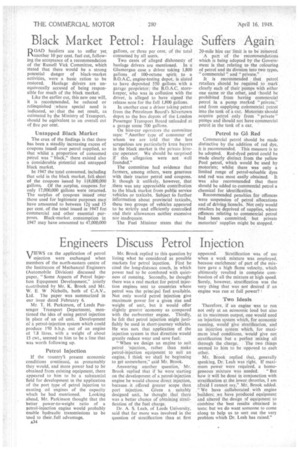Engineers Discuss Petrol Injection
Page 44

If you've noticed an error in this article please click here to report it so we can fix it.
'V IEWS on the application of petrol V injection were exchanged when members of the north-eastern centre of the Institution of Mechanical Engineers (Automobile Division) discussed the paper, "Some Aspects of Petrol Injection Equipment Development," jointly contributed by Mr. K. Brook and Mr. W. E. W Nicholls, both of C.A.V., Ltd. The paper was summarized in our issue dated February 6.
Mr. T. H. Parkinson, of Leeds Passenger Transport Department, mentioned the idea of using petrol injection in place of an oil unit. Development of a petrol-injection system which could produce 150 b.h.p. out of an engine 01 7.8 litres, with a weight of about 15 cwt., seemed to him to be a line that was worth following up.
Petrol Injection
If the country' present economic conditions continued, as presumably they would, and more power had to be obtained from existing equipment, there appeared to him to be a substantial field for development in the application of the port type of petrol injection to existing oil engines of the capacity which he had mentioned. Looking ahead, Mr. Parkinson thought that the better power-to-weight ratio of a petrol-injection engine would probably enable hydraulic transmissions to be used to their.full advantage.
A34 Mr. Brook replied to this question by listing what he considered as possible markets for petrol injection. First he cited the long-distance coach, in which power had to be combined with quietness of running. Secondly, he thought there was a real market for petrol injection engines sent to countries where petrol was the princ;pal fuel available. Not only would petrol injection give maximum power for a given size and weight of unit, but it would offer slightly greater "economy as compared with the carburetter engine. Thirdly, he felt that petrol injection might justifiably be used in short-journey vehicles. He was suri, that application of the injection system in that direction would greatly reduce wear and save fuel.
"When we design an engine to suit petrol 'njection, rather than make petrol-injection equipment to suit an engine, I, think we shall be beginning to get somewhere," said Mr. Brook.
. Answering' another question,' Mr. Brook replied that if he were starting on the development of a petrol-injection engine he would choose direct injection, because it offered greater scope than port injection. Gigen a suitably designed unit, he thought . that there was a better chance of obtaining stratification of the fuel charge.
Dr. A. S. Leah. of Leeds University, said that far more was involved in the question of stratification than at first appeared. Stratification was of use when a weak mixture was employed, because enrichment of part of the mixture gave a high flame velocity, which ultimately resulted in complete combustion of all the mixture at high speed. Surely, however, stratification was the very thing that was not desired if an engine was run at full power?
Two Ideals Therefore, if an engine was to run not only at an economic load but also at its maximum output, one would need an injection system which, for economic running, would give stratification, and an injection syStem. which, far Maximum load conditions, would give not stratification but 'a perfect 'mixing all through the charge.. The two things seemed to him to be opposed to each
other. , Mr. Brook replied that, generally speaking, Dr. Leah was right. If maximum power were required, a homo geneous mixture was needed. "But how it will be done in conjunction with stratification at .the lower. throttles, I am afraid Icannot say," Mr. Brook added. " We have cellaborated with engine builders; we have produced equipment and altered the design of equipment to combine' the best results obtained in tests; but we do want someone to came along to help us to sort out the very problem which Dr. Leah has raised."












































































